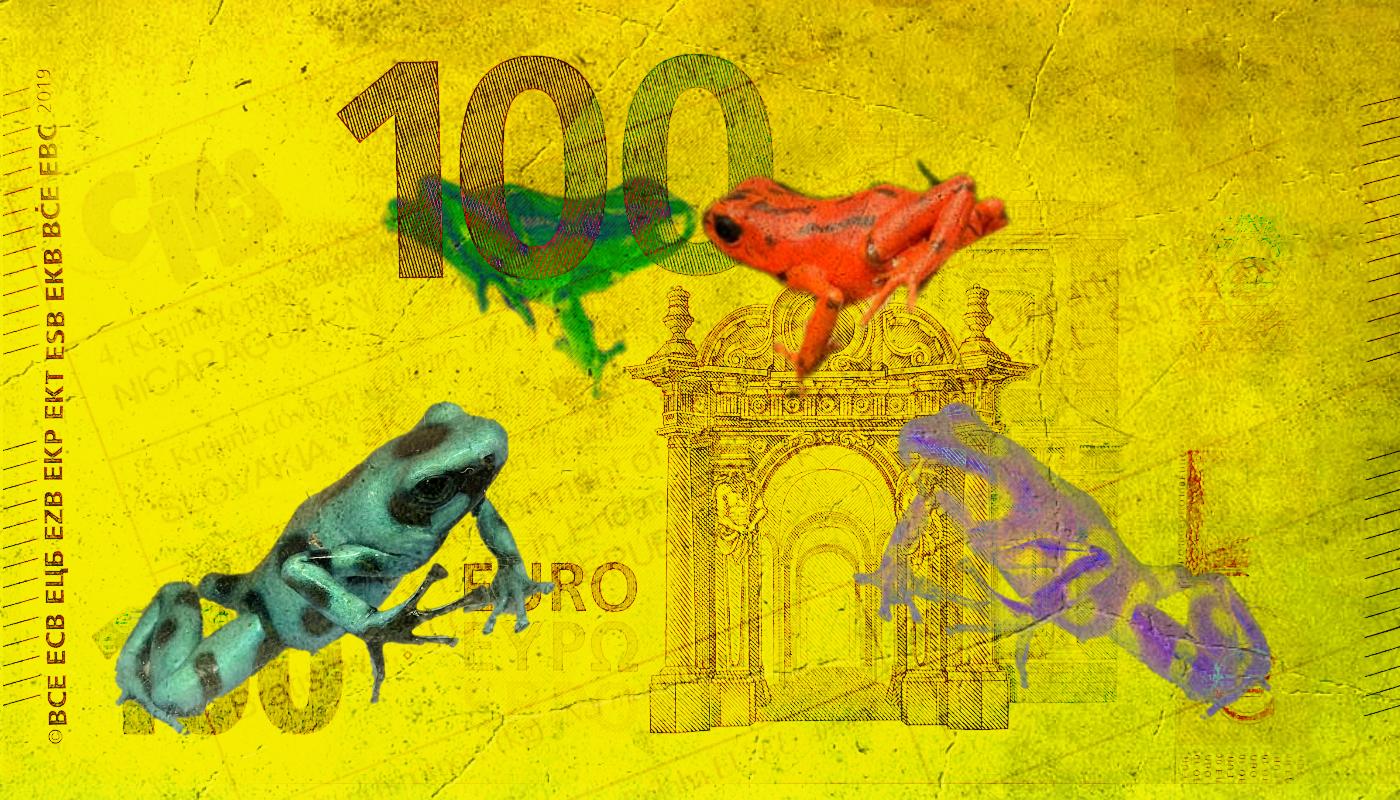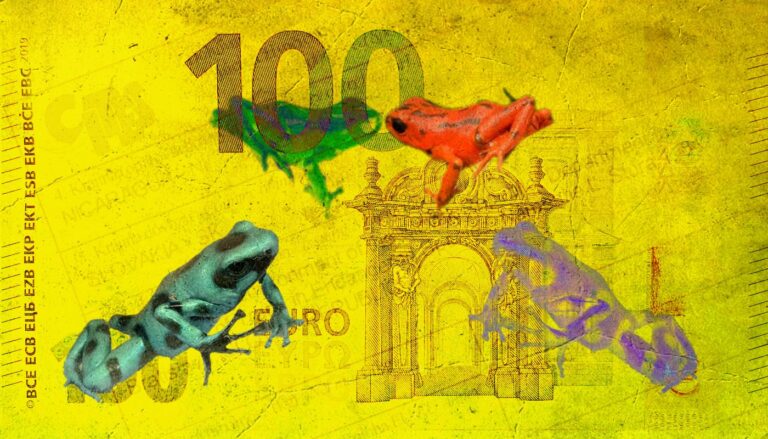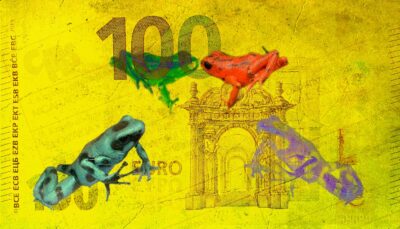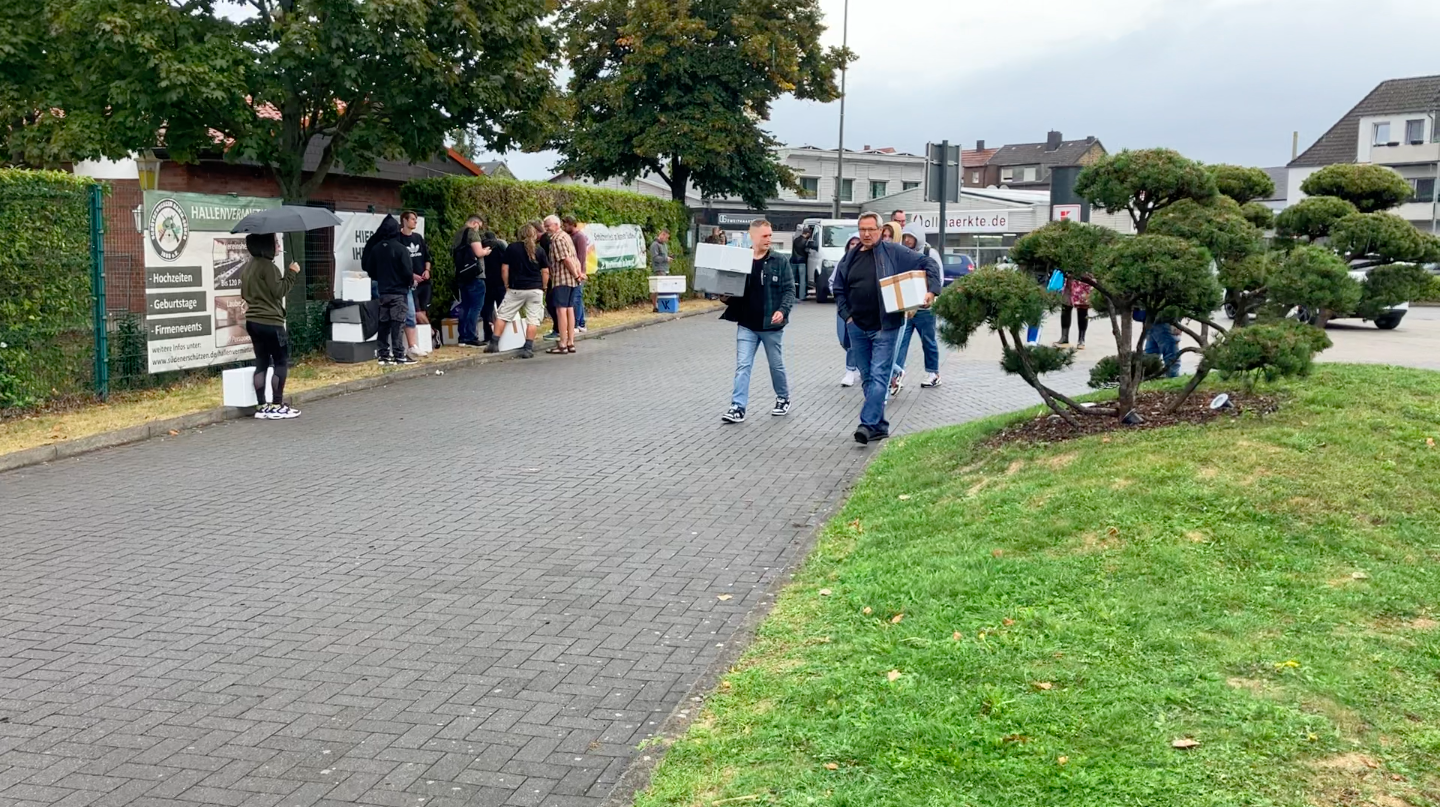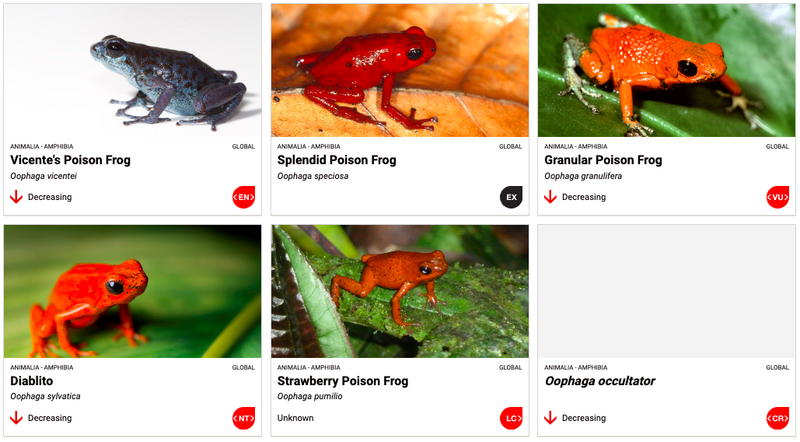by Tomáš Madleňák (ICJK.sk) and Andrea Rehmsmeier
German law enforcement authorities speak of a “frog mafia,” an animal-smuggling ring with a Slovak connection. The group may have imported endangered species of poisonous amphibians from Central and South America worth between 180,000 and 2 million euros. Despite the fact that they were caught red handed, some of them they got away with only 1500 euro fines.
Editor’s note: We know the full names of the actors, but we do not mention them in the text due to the fact that in Germany criminal proceedings against them have been suspended and in Slovakia criminal prosecution is currently underway on the matter, but without any specific persons being charged. The German authorities have not provided the names of the accused, but their involvement in the cases was confirmed to us by several other sources, and many of the activities were described by the actors themselves, with whom we spoke several times in extensive phone calls and also communicated in writing.
It is Tuesday, March 17, 2020. After a long journey, Tatiana is finally sleeping in a hotel room in the German city of Hamm. Tatiana is Slovak. Her husband, Sidney, is American. Both of them were living in Banská Bystrica, Slovakia, at the time, but they travel to Hamm quite often.
Tatiana and Sidney have an unusual hobby – breeding poison dart frogs, the tiny Central and South American amphibians known for their bright colors and toxic skin.
At six in the morning, the German police broke into Tatiana’s hotel room and arrested her. They confiscated a number of styrofoam boxes spread all over the room. What was in them? More than 112 protected frogs.
She showed them the frogs’ papers – export permits issued in Nicaragua and import permits from the Slovak Ministry of Environment. But she had a problem.
There are many types of poison dart frogs, and some are rarer than others. Tatiana had permits to import several species, but the police also found four very rare red Vicente’s poison frogs (Oophaga vicentei), which no one has ever imported to Europe. Well, at least not legally. A single specimen can fetch up to 3,000 euros on the black market.
It turned out that the other poison dart frogs the German authorities seized from Tatiana were of questionable origin. Tatiana had import permits for frogs from breeding stations, but most of these frogs were still secreting toxins, a clear sign they were wild caught. When these frogs are bred in captivity, they lose their poison.
Two and a half years later, the ICJK’s sources from the German Customs Investigation Bureau are talking about the existence of a “frog mafia,” but two Germans got away with only 1,500 euro fines.
According to the ICJK’s source, in 2020 the Germans acted on a tip from the Slovak police, who had been investigating Tatiana and Sidney for years but wanted to catch them in the act of smuggling. They waited until Tatiana left for business and informed their German colleagues.
Tatiana was eventually released after being questioned. She then returned to Slovakia, but the Slovak police in Banská Bystrica did nothing to follow up on the investigation.
After all, it was 2020, the COVID-19 pandemic was starting, and Tatiana was in quarantine after returning from a trip abroad. A source close to law enforcement authorities, who spoke to us on condition of anonymity, claims that the local police were afraid of COVID-19 but more importantly did not feel the need to do a house search “just because of a few frogs.” The prosecutor overlooking the case allegedly shared the same view.
Pavel Matulay, a police officer specializing in environmental crime at the Slovak Presidium of the Police Force, told us that “we can confirm that we are aware of the apprehension of a certain Slovak citizen with 112 protected poison dart frogs without any valid commercial papers. We can also confirm that the Slovak Police are conducting a criminal investigation of the illegal poison dart frog trade, which would fall under Section 305 of the Slovak Criminal Code – Violation of Flora and Fauna Protection – with a possible penalty of up to three years of imprisonment.” He added that none of the multiple suspects have been formally charged in the case and that no on-site inspections of breeding facilities were ever conducted.
At the time, only police officers from Banská Bystrica could have carried out a search, as Bratislava-based environmental crime investigators from Matulay’s department did not have the authority to do so. When asked why the police did not act, Denisa Bárdyová, spokeswoman for the Presidium of the Police Force, responded: “We checked the reasons for not carrying out the house search you mentioned in 2020. We found that despite the efforts of the police officers of the Regional Directorate of the Police Force in Banská Bystrica, it was not possible to obtain a warrant to carry out a house search and a search of other premises and land from the relevant prosecutor’s office.”
We then turned to the prosecutor’s office with questions but did not receive an answer.
Due to the passivity of the Slovak police and the prosecutor’s office, the couple from Banská Bystrica managed to get rid of the other frogs in the following months. According to our findings, even after the German police confiscated 112 frogs from her in March 2020, Tatiana continued to keep other frogs at her breeding facility, including those for which she could not have had legal papers.
In June of the same year, Tatiana traveled to the German city of Hamm again, where she sold more illegally held red Vicente’s poison frogs to a Swiss breeder in a parking lot. This was confirmed by the Swiss breeder himself, who later had these frogs confiscated by Swiss customs officials.
Today, Tatiana and Sidney live in Texas, where they still breed frogs.
Slovak Connection
Trade in endangered species is regulated by the CITES treaty through a system of export and import permits. For poison dart frogs from the genus Oophaga, such permits are granted only for frogs from regulated farms and never for wild-caught ones.
Tatiana and Sidney’s case exposes the limits of the CITES treaties. Between 2016 and 2020 they managed to get all the permits necessary for importing 500 endangered strawberry poison frogs (Oophaga pumilio) from Nicaragua, 77 critically endangered harlequin poison frogs (Oophaga histrionica) from Colombia, and 32 critically endangered Lehmann’s poison frogs (Oophaga lehmanni) from Colombia. All this despite the fact that their activities had already aroused the interest of the Slovak authorities. In 2017 and 2018 the Slovak Ministry of Environment repeatedly denied the pair import permits for 800 strawberry poison frogs due to the fact that the breeding facilities they came from were not approved by the CITES scientific review board.
Nevertheless, Tatiana and Sidney still obtained permits to import hundreds of different poison dart frogs. However, they were never granted permission to import Vicente’s poison frogs, the species that the German police found during their search of Tatiana’s hotel room.
When we spoke to Sidney on the phone about these frogs, he asked us, with anger in his voice, “And who said they were endangered at all?” Like Tatiana, he never agreed to let us record our phone call with him.
Tatiana and Sidney both argued that they acquired their frogs completely legally, telling us where and how they got them. However, their stories do not fully line up.
They were unable to give us plausible explanations of where they got at least four red Vicente’s poison frogs and of how it is possible that almost all the frogs seized by the German police in Hamm had toxins in their skin, a telltale sign that they were caught in the wild.
For Sale: Imported Frogs
Sidney has been in the frog business for much longer than Tatiana. Her breeding facility in Banská Bystrica was approved by the State Veterinary and Food Administration of the Slovak Republic in November 2016. At that time, she was already living together with Sidney in Banská Bystrica. She is a lawyer, and he worked as a personal trainer at her father’s fitness center.
In a telephone interview Tatiana told us that she has always loved animals. When she was younger, she would bring home injured pigeons she found in town to treat them. She also told us that she took out a loan to set up her frog-breeding station.
Even before her facility was approved, she obtained an export permit for 300 strawberry poison frogs from a breeding station in Nicaragua. The Slovak Ministry of Environment would later issue an import permit.
Unfortunately, all these frogs died during transport. During our conversation, Tatiana blamed airport workers for leaving the boxes of frogs outside in the freezing weather, even though they were clearly marked as containing live animals.
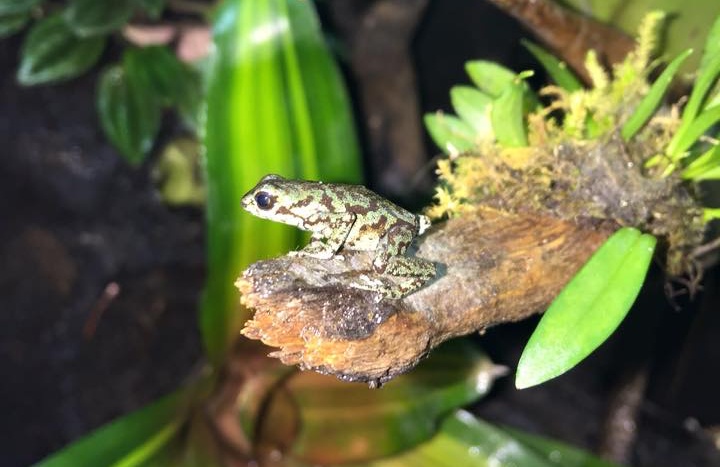
A Vicente’s poison frog. Sidney bragged about them on Facebook in 2016, but he claims that he took photos of them in his breeding facility in the USA, not in Banská Bystrica. Source: Facebook/Motherfroggers
At approximately the same time, she was first denied a permit for importing strawberry poison frogs, as mentioned.
However, other permit requests were successful. She imported dozens of rare, expensive Lehmann’s and harlequin poison frogs from Colombia. In 2019, she was granted an import permit for 300 strawberry poison frogs from Nicaragua.
A source familiar with the work of the German Customs Investigation Bureau said that although Tatiana had papers to import frogs from Nicaragua, the plane that transported them arrived from Panama. The source, who spoke to us on condition of anonymity, said that “we have bills of lading showing that the frogs were flown out from Panama City Airport to the European Union, almost always to Germany. But we don’t have permission to fly the animals from Nicaragua to Germany via Panama. There is only the export license from Nicaragua to Slovakia and the flight from Panama to Germany. But the intermediary piece is missing.”
When confronted with this information, Sidney told us that he has no control over how airlines fly.
Our source from the German Customs Investigation Bureau disagrees: “It would have to be explicitly noted on the CITES export permit if the animals cross a transit country. So I assume that these frogs, which are declared as breeding animals from Nicaragua, have never seen Nicaragua.”
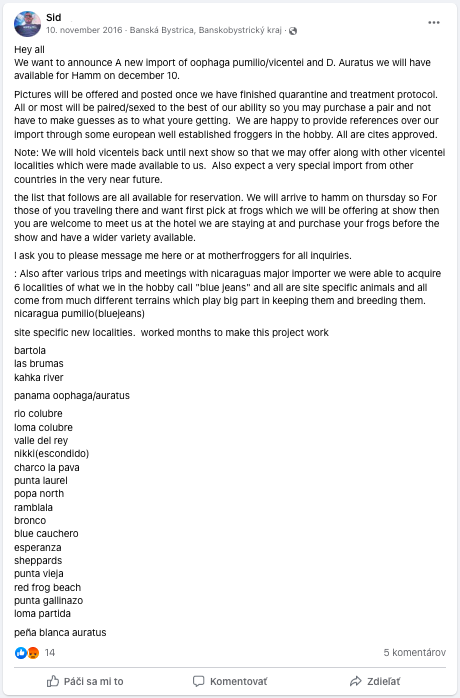
Sidney’s ad. Officially, animal trading is prohibited on Facebook, but frogs are commonly sold in groups. Source: Facebook
Vicente’s poison frog, which the German police found in Tatiana’s hotel room, is found exclusively in Panama. It closely resembles the strawberry poison frog and can be easily misidentified as such by someone not so knowledgeable about frogs. Tatiana imported hundreds of these strawberry poison frogs – officially from Nicaragua, but the plane flew from Panama.
When Tatiana submitted her first import requests in 2016, Sidney published an ad on Facebook offering for sale both imported frog species – the strawberry poison frog (Oophaga pumilio) and Vicente’s poison frog (Oophaga vicentei): “We want to announce a new import of oophaga pumilio/vicentei… we will have available for Hamm on December 10. … We will hold vicenteis back until [the] next show [Terraristika in Hamm in March] so that we may offer [them] along with other Vicentei localities which were made available to us…” Sidney wrote. He also specifically mentioned localities in Panama. He also explicitly stated that all imports were CITES approved.
Over the phone, Sidney explained to us that at the time he was waiting for the approval of the import application from Panama, which was ultimately rejected by the Slovak ministry, putting the whole deal off.
However, they applied for permission to import strawberry poison frogs and some green-and-black poison frogs (Dendrobates auratus). They did not request a permit for any Vicente’s poison frogs. In the Facebook ad, Sidney practically admits that he and Tatiana were planning to import Vicente’s poison frogs from Panama.
What happens in Hamm?
Hamm is, by German standards, a small, little-known city in the state of North Rhine-Westphalia. It has 179,000 inhabitants and is located about 44 kilometers from the better-known Dortmund.
It is no coincidence that Tatiana was detained by the police in this very city. The average person may have never heard of it, but it is very well known to anyone who has ever been interested in terrariums and amphibians or reptiles.
The largest European terrarium expo – Terraristika Hamm – is held in Hamm four times a year.
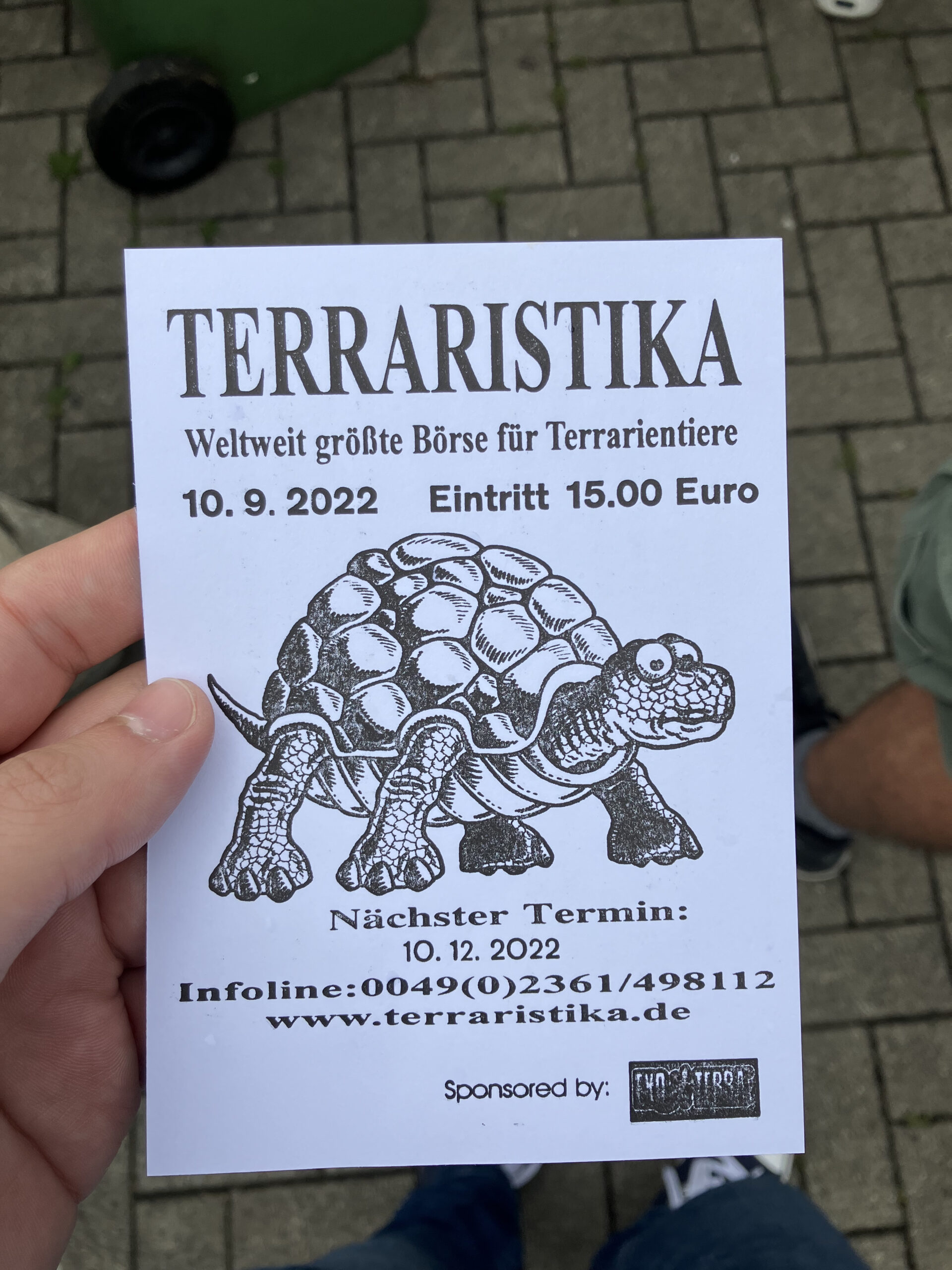
Entrance ticket to the largest reptile and amphibian expo in Europe, which is held in Hamm. Source: ICJK
To understand the massive business that the terrarium-animal trade is, we decided to travel to Hamm ourselves.
We leave our hotel for the central hall early Saturday morning. It’s eight a.m. and lines are starting to form, even though the gates don’t open until ten.
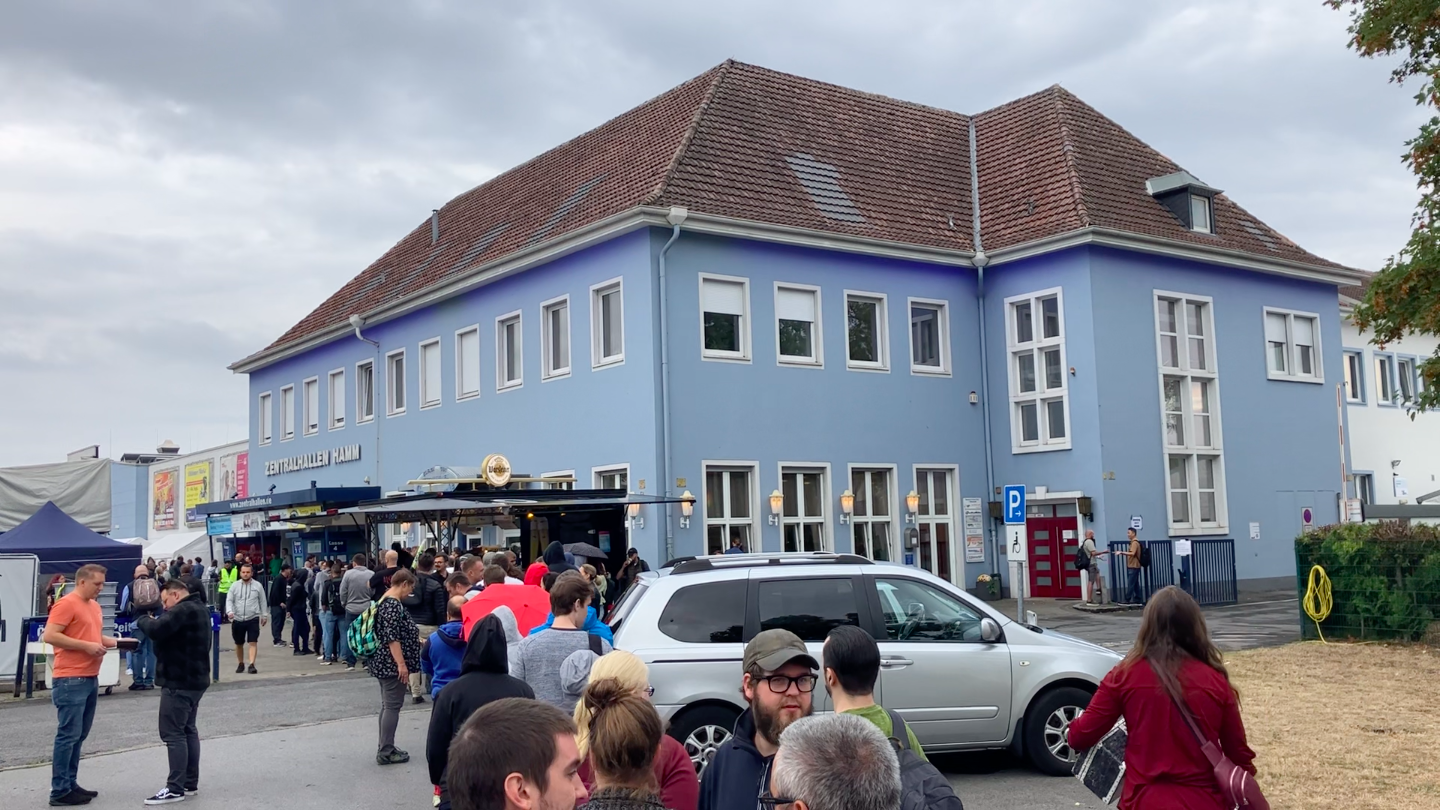
In the long lines waiting to get into the expo, you can hear people speaking German, English, French, Spanish, Italian, Czech, and Polish. Terrarium enthusiasts from all over Europe and beyond meet here four times a year. Source: ICJK
Lots of people holding styrofoam boxes are standing in the parking lots near the central hall. Every so often, someone will approach one of them, and money and boxes quickly exchange hands.
The couple from Banská Bystrica also sold their frogs in this way. Sometimes such deals are legal, but not always. At the expo, we later find out that Tatiana and Sidney are very well-known names in these circles.
“Who said they were endangered at all?”
To answer the question Sidney angrily posed to us, it is the International Union for Conservation of Nature (IUCN) that said these frogs were endangered. In fact all species of Oophaga dart frogs are included on the IUCN’s Red List of Threatened Species.
Several of them were still common in the 1970s. However, their wild populations have been radically reduced since, in part because of their excessive collection from the wild for the global pet trade.
The problem with the dwindling population of frogs living in the wild was to be solved by farms, where frogs would be bred in captivity and sold to international clients. However, as our case shows, some farms can also serve as cover for the sale of wild-caught frogs.
“The export of animals collected from the wild should be completely prohibited by law,” says Samuel Sucre, biologist, conservationist, and the owner of one such farm in Panama, where he breeds poison dart frogs. Samuel is one of the “good guys.” He believes that by increasing the supply of legal captive-bred animals, the demand for wild-caught animals can be reduced.
Although he is part of the international frog trade, he supports stricter regulation: “That would be the most effective method against wildlife smuggling. Because legal exports can all too easily be misused to cover poaching and smuggling. Pet owners in Europe just need to say: ‘My poison dart frogs come from a breeding line of parent animals that were legally imported five years ago. I kept them myself.’”
Through Samuel, we met people in Panama who knew about the invalid papers from Nicaragua and the halted investigations in Slovakia. And about the English-speaking man and his Slovak partner, who are considered the main suspects in the case. “Do you mean Sidney from Texas and Tatiana, who owns a registered breeding station in the Slovak city of Banská Bystrica?” one of the people we spoke to asks us, after we start describing the case.
Sidney clearly enjoyed Panama and was even planning on moving there. One of the locals, who is also in the frog business, told us how one day he got a message from Sidney that read,“Hi, I’m starting this thing in Panama. You are also an entrepreneur, so you should know about it. I bought a plot of land in Panama. I’ll send you pictures of the frogs I found there!”
According to the locals, Sidney paid Panamanian children a few dollars for each frog they brought him. Vicente’s poison frogs are arboreal, so they had to climb trees to get them.
Later, law enforcement reports would state that the seized illegally imported poison dart frogs came from Panama, where smugglers paid children to climb trees. However, in our later phone call, Sidney defended himself, stating that, yes, he had paid children to bring frogs to him, but only so he could photograph them. And there is nothing illegal about that.
But Sidney also confirmed that he bought a plot of land in Panama, supposedly with a house. He said that he wanted to open a farm for poison dart frogs himself. But his plan failed when one of his employees was caught by the Panamanian police with hundreds of illegal frogs. Sidney claims that this worker had these frogs for someone else, without Sidney’s knowledge.
Can the people at the border tell the frogs apart?
Both Tatiana and Sidney deny that the four Vicente’s poison frogs that were seized from Tatiana in Hamm in March 2020 were imported by them in late 2019. They had a permit to import only strawberry poison frogs from Nicaragua.
Both described this claim to be nonsense, since, as they argue, a veterinarian is always present when shipments of live animals are opened at the border for inspection, and he or she would immediately notice the difference in these two species.
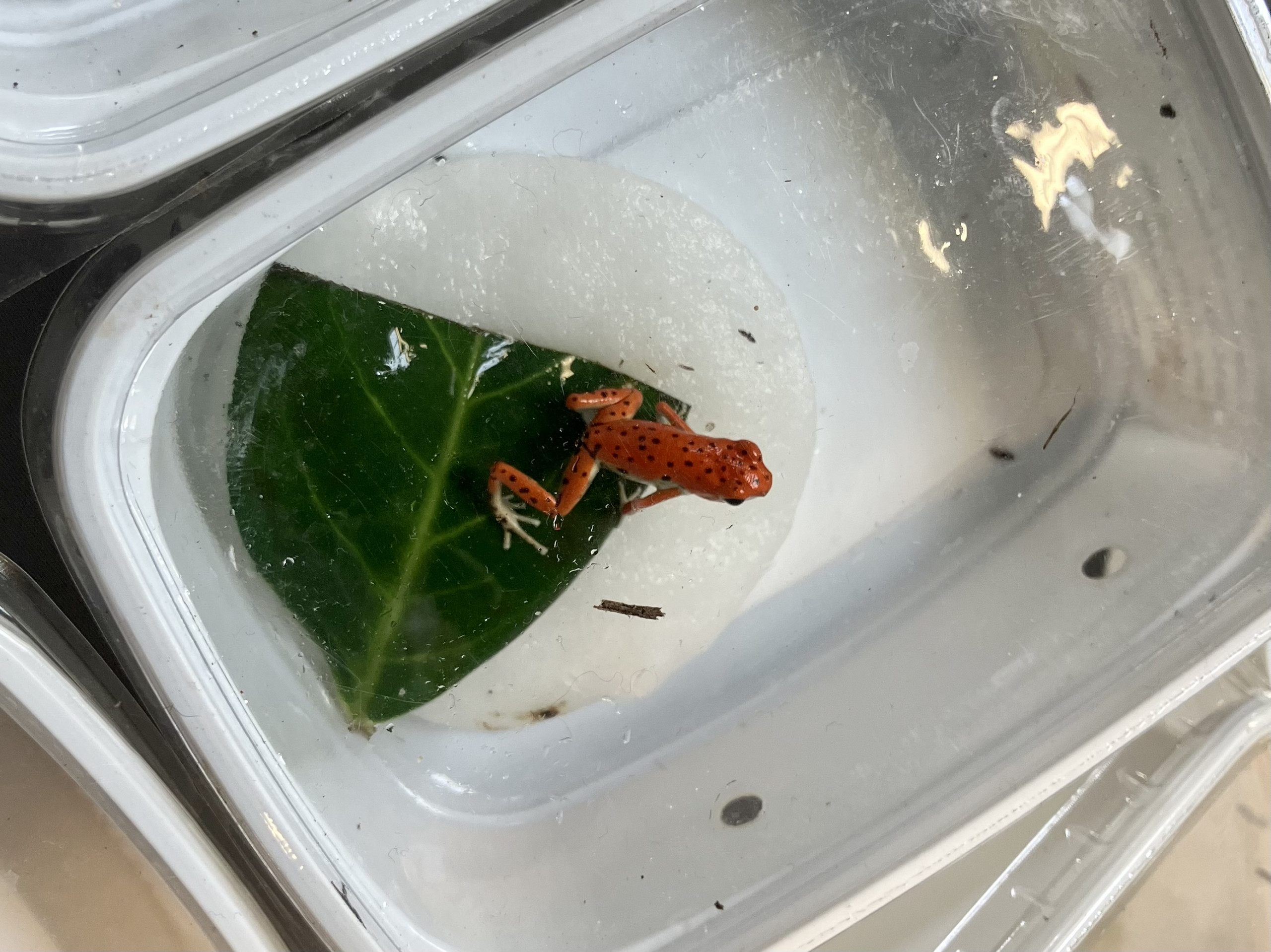
One of the many color variants of the strawberry poison frog (Oophaga pumilio). They can also be green, yellow or blue with black dots, or red with blue legs. We photographed this one at the Hamm expo in 2022. Source: ICJK
However, a source from the German Customs Investigation Bureau is not so sure about the ability of German officials to distinguish the strawberry poison frog from Vicente’s poison frog. This source told us verbatim that the customs investigators believe frogs were imported “as strawberry poison frogs, but they could also have been Panamanian Vicente’s poison frogs.”
The ICJK was unable to find an expert in Slovakia who could reliably distinguish these two species. The Ministry of Environment of the Slovak Republic confirmed this, telling us they would have to call an expert from the Netherlands if necessary.
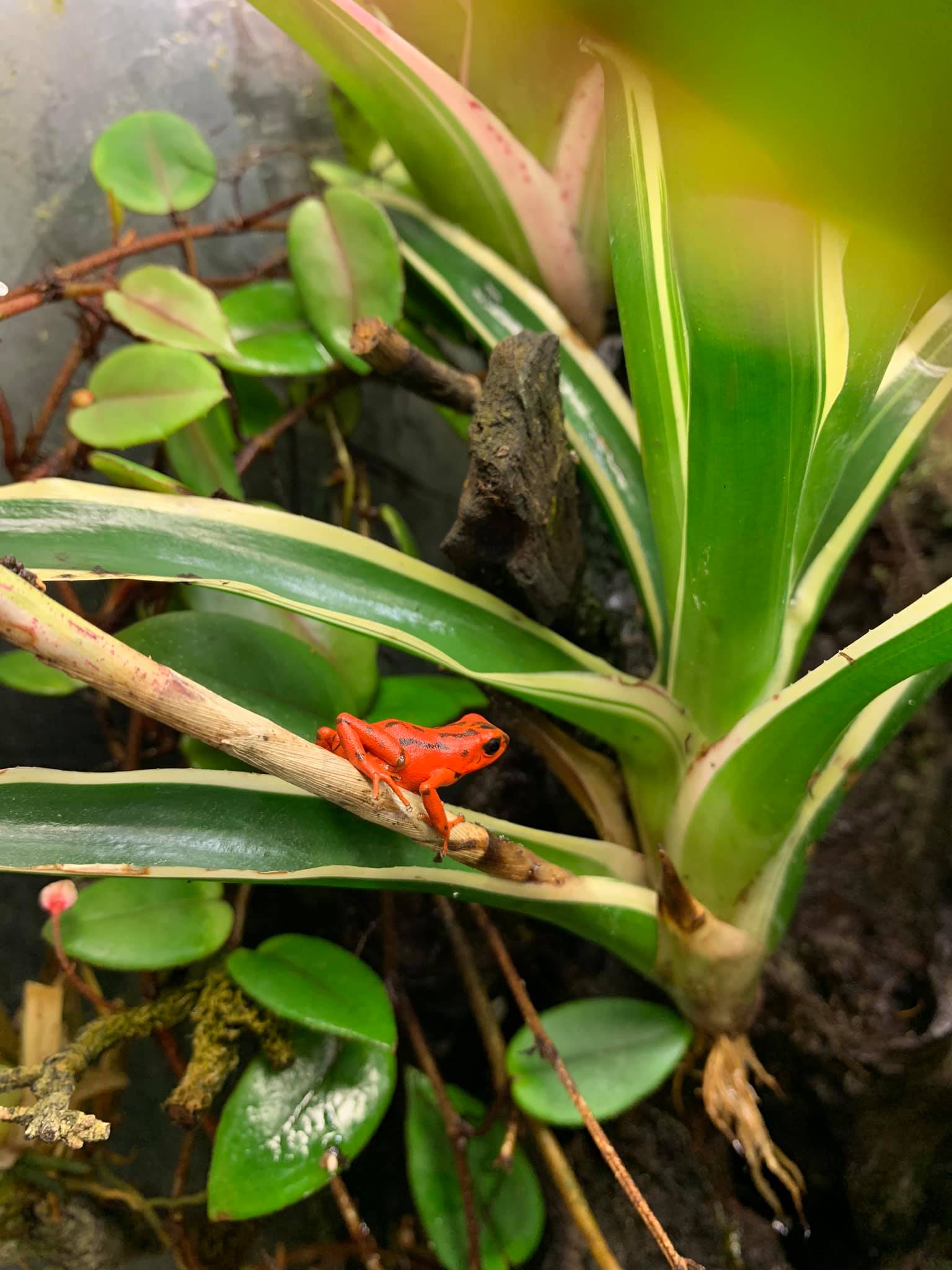
One of the color mutations of Vicente’s poison frog (Oophaga vicentei). These Panamanian frogs also come in several colors and grow to about the same size as the strawberry poison frog. This is a photo of the Vicente’s poison frog bought from Sidney and Tatiana in 2020 by a Swiss breeder. Source: Facebook/Oophaga -pumilio -escudo -granulifera -vicentei
What color were the scientist’s frogs?
Despite what our findings suggest, Tatiana maintains she legally obtained the Vicente’s poison frogs that the German police confiscated. She claims that they are the descendants of frogs that Dr. Karl-Heinz Jungfer brought to Germany in the 1980s. He sold his frogs to another German breeder, who eventually sold them to Tatiana in 2020.
Dr. Jungfer is one of the three discoverers of Vicente’s poison frog. He first described this species in a 1996 scientific article co-authored with two colleagues.
In 1987, these researchers brought several Vicente’s poison frogs to Germany from Panama. However, as this species had not yet been officially described, they were declared in import documents to be frogs belonging to the genus Dendrobates.
Only after being carefully studied in Germany were they declared a new species.
Tatiana sent us a document, a letter that Dr. Jungfer himself wrote in 2020, confirming that after the scientific study was finished, he sold the frogs to a German breeder, named Andreas Maxion.
Tatiana also provided us with a receipt for the purchase of eight Vicente’s poison frogs from Andreas Maxion, dated January 26, 2020. She claims that since she did not import them, she does not even need a CITES import permit; in Europe such a certificate of origin is supposed to be sufficient.
However, according to German customs officials, all the frogs that were imported by Dr. Jungfer were green. All of Tatiana’s frogs seized by the German police were red.
Jan Thuma, a frog breeder at the Prague Zoo, rejects the idea that green frogs can become red, even after several generations: “In 12 years of breeding Oophagas, I have never had a form other than green bred from a green line, nor a form other than red from a red one.”
Sources from the German Customs Investigation Bureau have identified Andreas Maxion as Tatiana and Sidney’s accomplice. According to our sources, the fact that Andreas’shis Vicente’s poison frogs can be traced back to Dr. Jungfer’s frogs can be used to issue false certificates of origin for frogs of the same species that actually came to Europe illegally.
Our colleagues from Germany repeatedly tried to contact breeder Andreas Maxion through several channels, but he never responded to our questions.
But there is still one major hole in Tatiana’s story about her frogs being descended from Dr. Jungfer’s: their toxicity.
Almighty Slovak aphids
Of the 112 poison dart frogs seized by the German police from Tatiana in Hamm in 2020, all but one had toxins in their skin, according to our sources familiar with the German customs investigation.
Neither the Vicente’s poison frogs nor the strawberry poison frogs, which were legally imported from Nicaragua, could have been captive bred. Recall that in captivity poison dart frogs lose their poison. This is because the poison is only formed in their skins when they live in the wild and eat local food – various small South and Central American insects.
So how is it possible that Tatiana’s frogs, all of which were supposedly captive bred in either Latin America or Germany, were poisonous?
In a telephone call, Sidney first doubted all experts who claim that poison dart frogs lose their poison in captivity. He challenged us to present him with proof that this was so. He, as he claimed, as an experienced breeder, knows best that poison dart frogs do not actually lose their poison, and those who claim otherwise know nothing about breeding poison dart frogs.
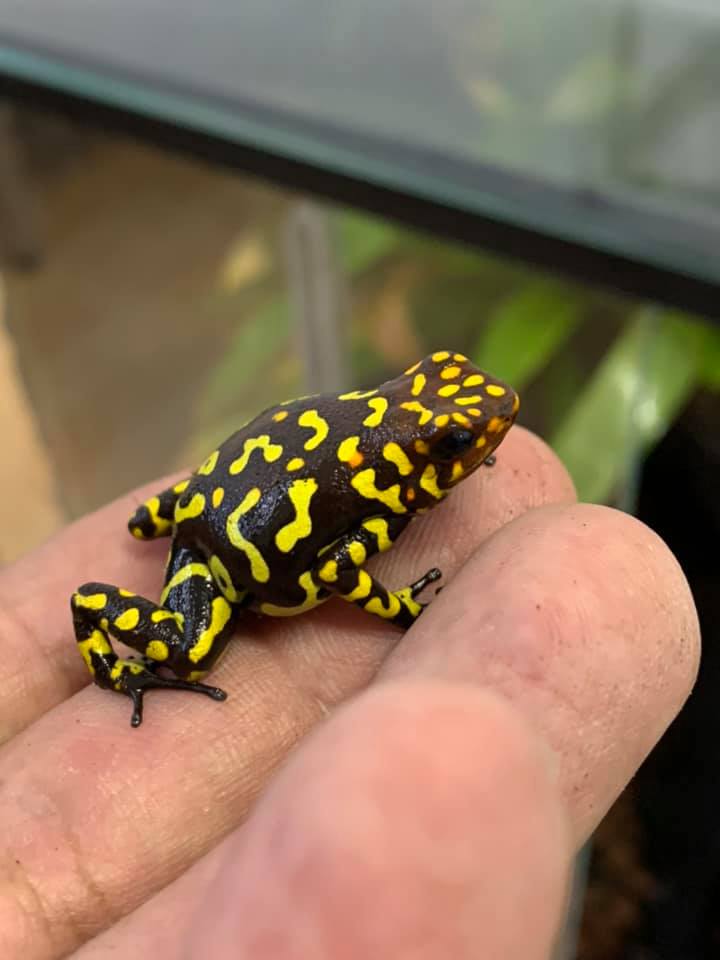
Wild poison dart frogs pack a poison 200 times more potent than morphine. However, in captivity, they lose this poison, allowing breeders to take photos of them on their ungloved hands. Source: Facebook/Motherfroggers
A few minutes into the call, however, he changed his tactics and explanation: their frogs were still secreting poison despite being captive bred because he fed them insects that he collected in the wild around Banská Bystrica, specifically, black aphids.
Also, according to Sidney, sometimes other wild insects, ants and the like, wander into the terrariums and then are eaten by the frogs.
“Sometimes a spider gets into the frog’s terrarium, there are a lot of spiders in Slovakia and then the frogs eat them. And what do spiders have? Poison,” Sidney closed his case, striking an authoritative tone.
But then, why do other breeders’ frogs lose their poison? Don’t spiders get into their terrariums, too? This line of questioning irritated Sidney, who then changed his story once again.
He then said they bought the frogs from Nicaragua, from a breeding station that told them they were bred in captivity. If they were in fact collected from the wild, that was not his problem, he argued.
“Oophaga frogs, as well as all other genera and species of poison dart frogs, born and raised in human care are not poisonous. These frogs get their toxicity from natural food, which is completely unavailable in captivity and cannot be replaced by anything in our European environment,” Jan Thuma, Prague Zoo’s frog breeder, told us unequivocally.
Where did the remaining frogs end up?
The German authorities confiscated 112 frogs from Tatiana. In 2019, she legally imported 300 to Europe, and in the previous years she and Sidney had brought dozens more to Europe.
Tatiatia’s receipt from the German breeder Andreas Maxion indicates that she bought eight Vicente’s poison frogs from him. However, the German police only seized four. Other sources say six. Either way, at least two Vicente’s poison frogs are unaccounted for.
The German authorities have completed their investigation of the Andreas Maxion and another German breedersaccomplice. Both had to pay a fine of 1,500 euros, and the matter is done for them. Tatiana and Sidney moved to Texas and continue to breed frogs in the USA.
But where are the remaining endangered poison dart frogs?
Over the phone, Tatiana claimed that the German authorities took all her frogs. After the raid, all she had left were the terrariums, some other equipment, and an unpaid bank loan.
This, however, is not true. The State Veterinary and Food Administration of the Slovak Republic conducted an inspection of Tatiana’s breeding station in Banská Bystrica in September 2021. “In 2021, at the time of the official inspection, there were two pairs of animals of the strawberry poison frog species in the breeding facility,” the administration confirmed.
We also talked to the person who inspected the facility, who wishes to remain anonymous. He confirmed this information was true but added that he is not an expert on frogs and cannot distinguish different species of poison dart frogs.
Why did Tatiana lie to us? She did not respond to this question we sent her later.
Sidney told us during our phone conversation that they still had some frogs after Tatiana was apprehended in Germany, but he claimed they gave them all away. For free. Only to good hands.
In January 2022, Swiss customs issued a press release about a Swiss citizen who was selling endangered frogs originating from Panama over the internet.
According to the Swiss authorities, these protected frogs were collected by children in Panama who sold them to international smugglers, who then sold them in Hamm, among other places. According to the press release, persons “known to law enforcement authorities in Belgium, the Slovak Republic, Poland, the Netherlands, the Czech Republic, France, and Germany” were involved in the matter.
These are the same frogs that Sidney and Tatiana imported from Latin America. We managed to get in touch with the Swiss citizen whose frogs were confiscated by the Swiss authorities. Although the press release mentions 69 frogs, he claims only four were seized, all four of which were Vicente’s poison frogs, which he claims he bought from Sidney.
Tatiana brought them to him, he continues. He got them from her in the parking lot in front of the central hall in Hamm on June 20, 2020. If this is true, it means that less than four months after being apprehended, Tatiana traveled back to Hamm with illegal frogs.
The Swiss man alleges he did not know that he was buying something illegal: “They gave me papers and told me everything was legal. What a shame when the authorities came to my home and told me all the frogs from them have been illegally imported!”
Authorities across Europe remain lukewarm about smuggling
“We noticed that there are many people involved in this organization in many countries. You can almost talk about a frog mafia. Everyone has a role, and one wheel leads to another,” says a source from the German Customs Investigation Bureau, who wishes to remain anonymous, about Tatiana, Sidney, and the involved German breederstheir accomplices.
But if we could almost call their frog smuggling operation a “frog mafia,” then why, in the end, does it seem like no one cares too much about it?
The Swiss authorities estimated the price of the frogs they seized from the Swiss man we spoke with at around 5,700 euros. The press release says that he faces a fine of up to 40,000 Swiss francs and imprisonment for up to five years. According to our sources, in the end, he only received a fine of about 5,600 euros.
The two German breedersaccomplices of Tatiana and Sidney, who according to German officials helped smuggle the frogs and forge official documents, can already forget about the whole thing, too. The German prosecutor closed their cases after they both paid a fine of 1,500 euros each.
The criminal proceedings against Tatiana and Sidney have been suspended in Germany, as the police cannot get in touch with them. They were able to move from Slovakia to Texas without any complications.
The Slovak police played a key role in the whole investigation. The raid on Tatiana’s hotel room in Hamm would have never happened if it were not for the environmental crime specialists in Bratislava.
Subsequently, however, the police in Banská Bystrica and the supervising prosecutor’s office let the trail go cold. They effectively enabled Tatiana and Sidney to export and sell the remaining illegal frogs. And they never conducted an inspection of the breeding station.
Tatiana and her American husband Sidney, who both reportedly love nature and animals, imported at least 609 endangered and critically endangered frogs from Central America. The German authorities claim the number may be as high as 750. According to our sources from the German Customs Investigation Office, the black market value of these frogs could be as much as 2 million euros. Neither Tatiana nor Sidney were ever fined.
Poison dart frog populations in the rainforests of Latin America continue to decline.
The full version of this article in Slovak was published on icjk.sk
This article was developed with
the support of Journalismfund.eu.
Tomáš Madleňák is a Slovak journalist who has worked for the Investigative Center of Ján Kuciak since 2020. He is based in Bratislava.

